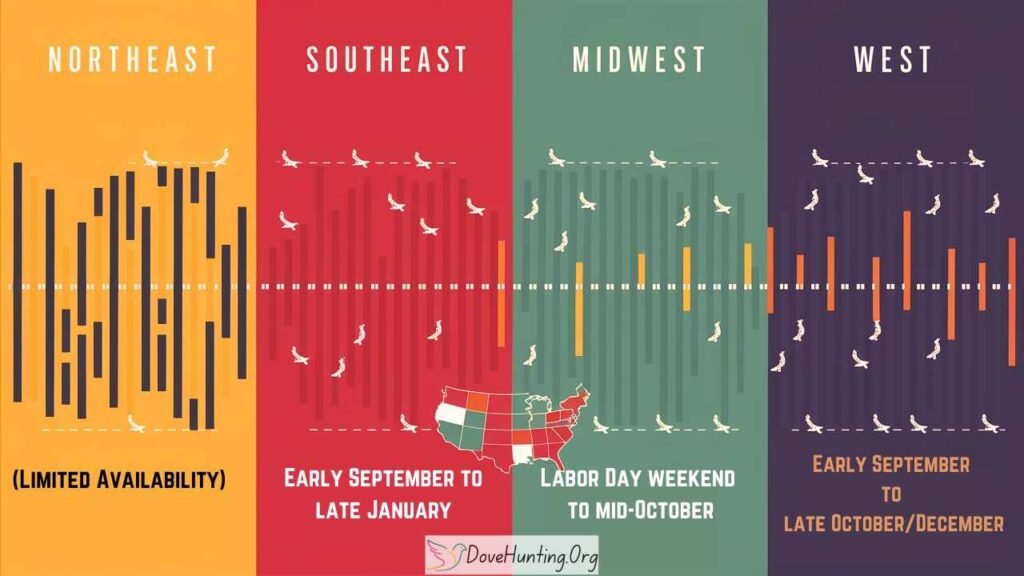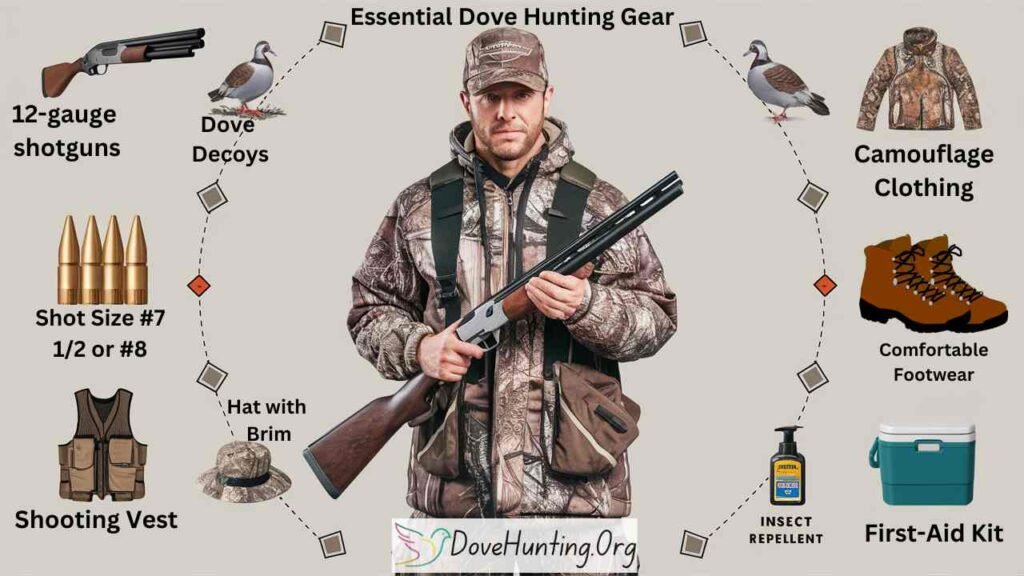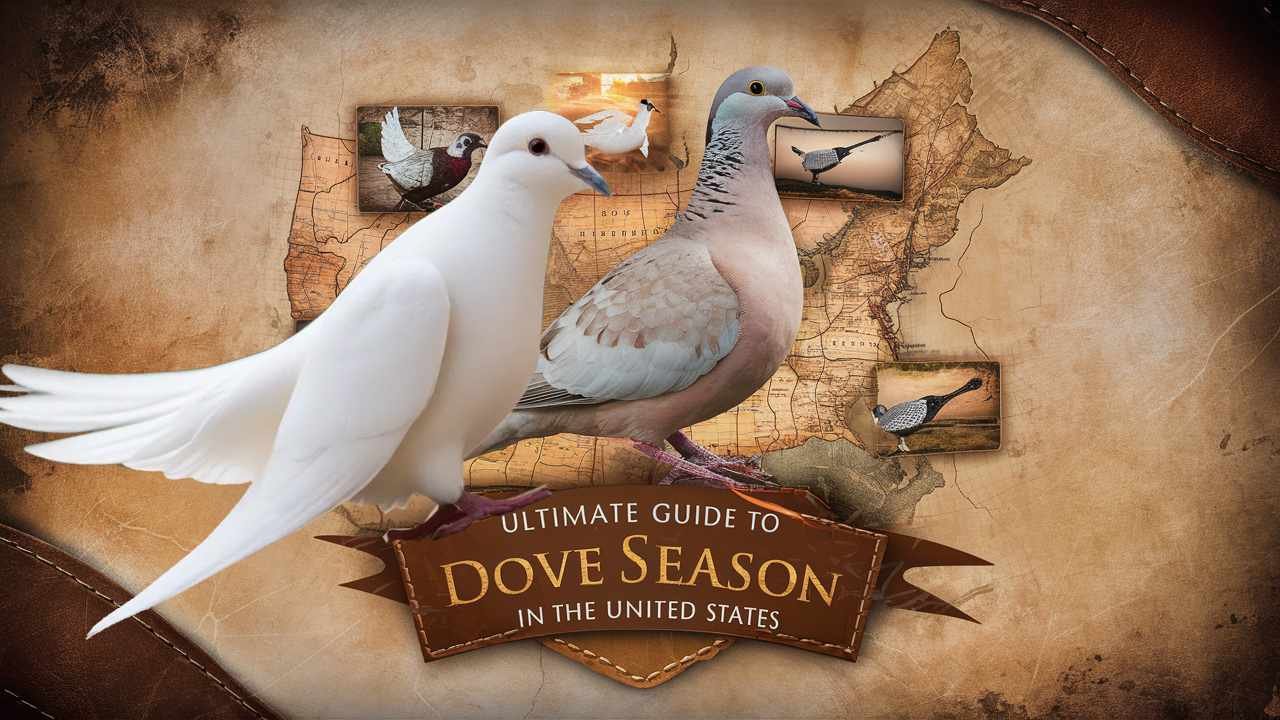The refreshing breeze, shared smiles of comrades, and the thrilling flurry of doves – this begins hunting season for many in the United States. It’s a ritual rooted in time, a check of agility and shooting skills, and a wonderful bond with nature.
Getting through dove hunting rules and plans might seem tricky. It’s often tougher for beginners or those trying new grounds. This complete handbook gives you all the key info. It prepares you for fun and fruitful dove hunting in 2024.
Plan Your 2024 Dove Hunting Adventure in the United States
Dove season dates vary considerably across the United States due to migratory patterns and population management strategies. Understanding these variations is crucial for planning your dove hunting adventure.
Which States Still Ban Mourning Dove Hunting?
It’s important to note that mourning dove hunting is currently prohibited in several northeastern states, including:
Keep in mind, many states ban hunting mourning doves due to worries about their numbers. They see these birds mainly as songbirds, underlining their place in nature. Yet, dove numbers have surged in past years, sparking talks about possible rule tweaks in these regions.
For the latest information on mourning dove hunting restrictions in specific states, it’s recommended to consult the official website of your state’s wildlife agency (https://www.fws.gov/).
Latest Dove Seasons by State
Given the huge size of America, the beginning and ending dates of the dove hunting season may vary greatly according to location. Here’s a quick look at common time periods for dove season:
| Region | Season Timeframe |
|---|---|
| Northeast | (Limited Availability) |
| Southeast | Early September to late January (split seasons possible) |
| Midwest | Labor Day weekend to mid-October |
| West | Early September to late October/December |

Always check your state’s wildlife agency site for dove hunting rules and current season dates. Why not use these handy resources?
- National Wildlife Federation: https://www.nwf.org/
- U.S. Fish and Wildlife Service: https://www.fws.gov/
Essential Dove Hunting Checklist
| Item | Description |
|---|---|
| Shotgun (12-gauge or 20-gauge) | Pump-action or semi-automatic shotgun |
| Ammunition | High-velocity, non-toxic shot (#7.5 or #8 shot size) |
| Camouflage Clothing | Breathable and comfortable for prevailing weather conditions |
| Dove Decoys (Optional) | Full-body and feeding decoy silhouettes |
| Shooting Vest | Provides storage for shells, calls, and other essentials |
| Comfortable Footwear | Boots or shoes suitable for walking and standing in fields |
| Hat with Brim | Provides sun protection and helps conceal your outline |
| Insect Repellent | Wards off mosquitos and other insects |
| Cooler | Keeps harvested doves fresh after the hunt |
| Hunting License | Required by all states for dove hunting |
| First-Aid Kit | Be prepared for minor injuries in the field |
| Folding Chair or Stool (Optional) | Enhances comfort during long periods of waiting |
| Sunscreen | Protects exposed skin from sun damage |
| Field Dressing Gloves (Optional) | Provides hygiene and comfort while cleaning doves |
Essential Gear for a Successful Dove Hunt
Now that you’ve familiarized yourself with the regulations, let’s turn our attention to the essential gear you’ll need for a productive dove hunt.
Here’s a breakdown of the key equipment to have on hand:
| Gear | Description |
|---|---|
| Shotgun | A reliable 12-gauge or 20-gauge shotgun is ideal for dove hunting. |
| Ammunition | Select high-quality shells loaded with non-toxic shot in sizes #7.5 or #8. |
| Camouflage Clothing | Blend in with your surroundings by wearing camouflage clothing that matches the local environment. |
| Doves Decoys (Optional) | Dove decoys can attract birds to your hunting location, but they are not essential for success. |
| Other Accessories | Additional items to consider include a shooting vest for carrying shells and additional gear, comfortable footwear suitable for walking in the field, a hat with a brim for sun protection, insect repellent, and a cooler to store your harvested doves. |

Step-by-Step Guide to Choosing the Perfect Shotgun and Ammunition
Selecting the Shotgun:
Doves are relatively small birds, so a shotgun with a gauge between 12 and 20 is perfectly adequate. Here’s a breakdown of the pros and cons of each gauge:
- 12-gauge: 12-gauge is a top pick among dove hunters. Why? Its range of shot sizes and loads. But, careful! Newbies might find the recoil a little rough.
- 20-gauge: Now, the 20-gauge. It’s lighter and easier to handle, perfect for petite shooters or those sensitive to recoil. But here’s the thing: 20-gauge has less shot, so picking the right shot is key.
Action Type:
Think about two main types of shotgun actions: pump-action and semi-automatic
- Pump-action: Pump-action is dependable and won’t go heavy on your pocket. After each shot, you’ve to slide the action to load a new shell.
- Semi-automatic: Semi-automatic, on the other hand, allows quick repeated shots. It’s a real boon during rapid dove hunting. But remember, semi-automatics usually cost more than pump-action types.
When it comes down to it, the top-notch dove-hunting shotgun is one that feels good to you, aims easily, and you can fire precisely. Feeling lost about which gun to pick? A smart move is to stop by a trusted firearm shop and seek advice from a well-informed seller.
Ammunition Selection:
- Non-Toxic Shot: Federal rules state that dove hunters should use safe shot during all migratory bird seasons. This includes options like steel, bismuth, and tungsten.
- Shot Size: It’s recommended to choose shot size #7 1/2 or #8 for dove hunting. These sizes offer a fair mix of shot pattern spread and range to successfully hunt doves.
Don’t forget, the right fitting shotgun is key for spot-on shooting. Not sure about the top-notch shotgun or bullets? Ask a trusted gun store or sports gear shop. They’ll guide you with professional advice and help pick gear that matches your body shape, shooting method, and hunting area.
Guidelines for Different Hunting Situations
Prepare for various dove hunting situations by observing weather and surroundings. If you’re hunting near water bodies, ensure you have waterproof footwear, waders, and be mindful of slippery areas. Consider a shooting blind for better concealment in large fields. Don’t forget your sunblock, hat, and sunglasses. If it’s hot, drink plenty of water and dress in loose clothing. During cold weather, dress in layers, carry hand warmers, and remember to bring a thermos of hot beverage. Gaining familiarity with these suggestions can elevate your hunting prowess.
Preparing for Open Field Dove Hunting
| Scenario | Considerations |
|---|---|
| Hunting Over Water | Waterproof boots and waders may be necessary. Be aware of potential hazards like uneven terrain or slippery surfaces. |
| Hunting in Open Fields | Sunscreen, sunglasses, and a hat are crucial for sun protection. Consider using a shooting blind for additional concealment. |
| Hunting in Hot Weather | Stay hydrated by bringing plenty of water. Choose lightweight, breathable clothing. |
| Hunting in Cold Weather | Layer your clothing to adjust to changing temperatures. Hand warmers and a thermos with hot beverages can be helpful. |
Recommended Dove Hunting Clothing (by Temperature)
| Temperature Range | Clothing Recommendation |
|---|---|
| Warm Weather (70°F and Above) | Breathable, lightweight camouflage clothing. Long pants are recommended for protection from brush and thorns. |
| Moderate Weather (50°F – 70°F) | Camouflage shirt and pants in heavier fabrics. Consider layering with a vest or jacket for added warmth. |
| Cool Weather (Below 50°F) | Insulated camouflage clothing. Layering with thermals and a hat is essential for staying comfortable in cold temperatures. |
Dove Hunting Tactics and Techniques
Let’s jump right into the thrilling universe of dove hunting strategies! This chapter offers tips for beginners and skilled hunters. It’s all about increasing your fun and triumph out in the wild.
Scouting Techniques for Locating Doves
The key to a productive dove hunt lies in locating birds. Here are some effective scouting techniques:
- Find Dove Food Spots: Mainly, doves feed on seeds and grains. Look for fields recently stripped of corn, sunflowers, wheat, or sorghum. These places are top spots for doves to eat, especially when they’re near water like ponds or streams.
- Observe Dove Activity: Look out for their activity early morning or late afternoon, as those are the times they’re most active. If you see birds flying or feeding in fields, it helps to notice their flight patterns to find potential resting places in close trees or power lines.
- Consult Local Hunters: Reach out to seasoned local dove hunters. They could offer useful information about best places to hunt and past dove activity patterns.
Setting Up an Effective Dove Hunting Blind
Once you’ve located a promising dove hunting spot, it’s time to create a comfortable and effective blind. Here are some tips:
- Camouflage is Crucial: Doves see really well. Find a spot where you can stay hidden or make a grassy blind from bushes, leaves, or coffee sacks. Use different colors like brown, green, and tan to look less noticeable
- Comfort Matters: When hunting doves, you may have to stay in one spot for a while. Pick a comfy spot to hide, or bring a chair or stool you can carry.
- Minimize Movement: Doves tend to fly away from sudden jerks. Be in your blind before the sun comes up and avoid moving or talking when not needed.
Decoy Usage Strategies for Attracting Doves
While not essential, dove decoys can be a valuable tool for attracting birds to your location. Here’s how to use them effectively:
- Variety is Key: Use both full-body and feeding mimic decoys. Set them up to mirror a real flock eating on the ground.
- Placement Matters: Spread your decoys around within your gunshot range. Some should be facing you, while others look away. This makes incoming doves feel safe.
- Action Draws Attention: Think about using moving-wing decoys that copy feeding actions. This is especially good at getting doves attention from far away.
Calling Techniques to Lure Doves (Optional)
Though dove calls aren’t used as much as in duck hunting, some hunters still choose these tools to lure birds. The calls echo the dove’s familiar coo, and how well they work changes based on where you are and how many other hunters are around.
Shooting Tips for Downed Doves
Doves fly fast, and you need a sharp eye and a steady hand to bag them. Check out these pointers to beef up your dove hunting skills:
- Aim Ahead: Don’t fire straight at the bird. Aim a smidge ahead of where the dove is going, factoring in how fast it’s zooming and how far away it is.
- Shot Placement Matters: Strive for a shot to the head or neck for an instant and painless takedown. Body shots might let the bird get away, hurt but not downed.
- Prep Your Firearm: Spend a bit of time at the range before you go hunting. Practice with the ammo you’ll use for the hunt to get a handle on your shotgun’s spread and the range it can handle.
Cleaning and Preparing Dove for Consumption
It’s important to clean your caught doves correctly to keep them fresh and yummy. Here’s your easy guide to cleaning:
- Cool birds First: Make sure the doves are totally cool before you clean them. Doing this helps keep the meat from spoiling and helps it stay tender.
- Plucking: Pull out the feathers gently, starting from the chest and going down. If you’d like, you can remove the doves’ skin too.
- Removing the insides: Take out the inside parts. Be careful not to poke a hole in the intestines.
- Cleaning: Lets the doves in cold water. This gets rid of any paper or trash.
- Cooling or Freezing: Put the cleaned doves in a cooler with ice for a short time. Or you can put them in the freezer if you’re going to keep them for a longer time.
Popular Dove Hunting Recipes
| Recipe Name | Description |
|---|---|
| Dove Piccata | Thinly sliced doves sauteed in a lemon butter sauce |
| Grilled Doves with Herb Marinade | Marinated doves grilled to perfection |
| Dove and Sausage Gumbo | A hearty stew featuring doves, sausage, vegetables, and rice |
| Smoked Doves | Doves seasoned and slow-smoked for a rich, smoky flavor |
| Crispy Fried Doves | Marinated and deep-fried doves for a classic Southern comfort food dish |
Dove Hunting Safety
Keeping safe is key when hunting. To stay safe during dove hunting, keep these points in mind:
- Hunter Orange Rules: Some states say hunters need an orange outfit during dove season. Always know and follow your state’s rules.
- Handle Your Gun Safely: Practice safe gun handling. Wait to load until it’s time to shoot, and manage where the gun points all the time.
- Stay alert. Look Out For Other Hunters: Dove hunting typically sees a spread-out group of hunters in an open area. Share your location with everyone and keep enough space. It’s key to never aim in another hunter’s direction or forget their position and firing zone.
- Identify Your Target: Know Your Bird before firing, make sure you have the right bird in sight. Mistakes between doves and other birds or shooting at low-flying doves could lead to harm, or tragically, loss of life.
Hunter Education is Key
It’s a great idea for newbie hunters to take a hunter education class. Even seasoned hunters can find something new in these refreshing sessions. They talk about key stuff like how to handle guns safely, identifying different kinds of wildlife, the right way to hunt and your responsibility as a hunter
By always keeping safety in mind during your dove hunting trips, you can have a fun, rewarding time with the others.
Helpful Mobile Apps for Dove Hunters
| App Name | Description |
| HuntStand | Provides hunting maps, public land boundaries, and weather forecasts |
| OnX Hunt | Offers detailed hunting maps, including property ownership and game management unit information |
| iHunt | Provides access to interactive hunting maps, scouting tools, and weather data |
| ShotShow Go | Connects users with hunting gear reviews, product information, and upcoming hunting shows |
Conclusion
This guide is a one-stop resource for your dove hunting needs. It helps you understand rules, seasons, choose the right equipment and enjoy the victory of a fruitful dove hunt in the United States. Keep in mind, dove hunting season isn’t just about reaching your bag limit. It’s about bonding with mother nature, cherishing the wilderness, and enjoying this activity with your loved ones.

